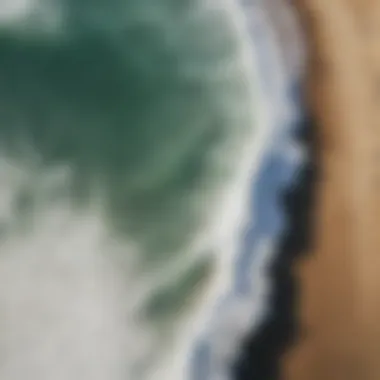Understanding Wave Height: Science of Surfing


Intro
Understanding the nuances of wave height is crucial, not just for those who ride the waves but for anyone interested in the oceans and their behaviors. Surfing isn't merely a sport; it’s a dance with nature. When surfers paddle into the ocean, they want to harness the highest waves, but what does that even mean? Wave height isn't a simple measure; it involves various scientific principles and environmental factors that determine how waves form, break, and ultimately create the surf experiences we cherish.
In this article, we will delve into several aspects of wave height, from the science behind its formation to how it influences surfing conditions. By bridging theoretical understanding with practical knowledge, we'll help surfers, regardless of their skill level, appreciate the art and science behind each ride.
Surf Gear and Equipment
When discussing wave height, the role of surf gear can't be understated. The right equipment isn’t just about personal preference; it’s about your safety and performance in the surf. Understanding how different surfboards and accessories are designed can radically impact how well you ride the waves.
Latest Surfboard Technologies
In recent times, surfboard technology has evolved by leaps and bounds. Innovations such as lightweight materials and hydrodynamic shapes enhance performance significantly. Boards like the Firewire Surfboards are crafted with eco-friendly materials and cutting-edge designs that not only reduce weight but also improve maneuverability on big waves.
- Epoxy vs. Polyurethane: Epoxy boards are generally more durable and float better, making them suitable for larger waves, while polyurethane boards offer a classic feel and flexibility.
- Tail Shapes: Different tail shapes influence how a surfer can turn and control their board in the water, depending on wave conditions. A rounded tail might suit softer waves, while a squarer tail is ideal for sharper, steeper breaks.
The choice of surfboard dictates not only performance but also safety as certain boards handle wave heights differently. A board that's too small for the height of the waves can spell trouble.
Essential Accessories for Surfers
Surfers need more than just a good board to ride the waves effectively. The right accessories can make a world of difference.
- Wetsuits: Depending on the surf locale, having the right wetsuit is pivotal. It enables the surfer to maintain body temperature in cold waters and provides some buoyancy.
- Leashes: Often overlooked, a sturdy leash is essential for keeping your board close, especially when riding larger waves.
- Wax: The right surfboard wax can help gain the traction needed to stay balanced on the board, which becomes increasingly important as wave height rises.
"The right gear is as important as understanding the wave itself. It’s the difference between catching the perfect wave and potentially facing injury."
Techniques and Skills
Riding waves requires more than just good equipment. It's about mastering techniques that harness the physics of wave height.
Wave Riding Strategies
Understanding wave patterns and height is crucial. Different strategies come into play depending on whether the waves are small or massive.
- Paddling Out: In larger swells, positioning becomes vital. Surfers need to paddle efficiently and choose the right moment to catch the wave.
- Timing Your Takeoff: For steep waves, the timing of your takeoff will dictate whether you wipe out or ride gracefully.
Reactions and adaptability to changing wave heights and conditions can greatly affect the quality of one's surfing experience.
Safety and Surf Etiquette
Surfing can be thrilling but comes with its share of risks. Safety should always be a priority. Knowing when to bail and understanding local surf etiquette can prevent accidents and cultivate a sense of community among surfers.
- Respect the Right of Way: Knowing who gets priority in the surf can prevent collissions and keep conditions safe.
- Know Your Limits: When faced with intimidating wave heights, it’s crucial to assess personal capabilities and not push them unreasonably.
Prolusion to Wave Height
Understanding wave height is crucial for anyone who has ever enjoyed the thrill of catching a wave. It's not merely a number on a surf report; it’s the heartbeat of surf culture. From the novice paddling out for the first time to the seasoned athlete seeking the perfect swell, wave height plays a pivotal role in the overall experience of surfing. This section provides an essential backdrop for the rest of our exploration, setting norms and parameters related to wave height.
Defining Wave Height
Wave height is defined as the vertical distance between the crest of a wave and its trough. This seems straightforward, but the nuances are what make it fascinating. Wave height can vary significantly depending on several factors like local conditions, winds, and the geographical landscape. An interesting tidbit is that measurement methods can create confusion—what one surfer deems a solid 6-foot wave might appear entirely different to another. Therefore, understanding how wave height is categorized helps surfers refine their skills and adapt to various surf conditions.
*
"It's important to remember that wave height can be deceptively different depending on where you are and who is measuring it."
*
Importance of Wave Height in Surfboarding
The significance of wave height in surfboarding goes far beyond just riding waves; it affects safety, performance, and choice. For instance, a surfboard that feels perfect on a knee-high wave might not handle well on an overhead swell. More importantly, safety becomes a major issue; understanding the height of waves can help surfers avoid risky situations. Here are a few points to ponder:
- Skill Level: Different skill levels require different wave heights. Newbies generally should stick to smaller, manageable waves. Advanced surfers, however, often seek out larger waves for the thrill they provide.
- Local Conditions: Some locations, like Huntington Beach, produce consistent conditions favorable for specific wave heights, while others might be more unpredictable.
- Personal Factors: A surfer’s experience and fitness level can radically alter their capability to ride certain wave heights. Recognizing this can lead to a much more enjoyable and safer experience on the water.
Ultimately, understanding wave height can inform choices about when and where to surf, enhancing not just the technical aspect of the sport but also the overall enjoyment duing each surf session. The relationship between surfer and wave is as intricate as it is profound—one not to be taken lightly.
The Science of Waves
In the context of surfing, understanding the science of waves is essential for anyone looking to ride them effectively. It delves into the essential mechanics that shape the ocean's surface and how they interact with other natural elements. Grasping the dynamics of wave formation is indispensable for both novice surfers paddling out for the first time and seasoned surfers searching for that perfect ride. Through this exploration, readers can not only enhance their surfing experiences, but also appreciate the complex interplay between wind, water, and the earth beneath.
Wave Formation and Mechanics
Waves, fundamentally, are energy traveling through water; they can be influenced by myriad factors. They form when the wind blows across the surface of the ocean, applying pressure and transferring energy to the water. This process causes ripples, and as these grow larger, they become the waves surfers are eager to ride. The mechanics behind this process occur in stages—initially, there's the build-up of small waves which can mature into larger swells when conditions allow. For surfers, understanding this transition helps predict when to hit the waves for optimal riding conditions.
When a wave reaches shallow waters, it begins to break. This is often where the thrill lies for surfers, as they ride the wave's energy toward the shore. Different types of break—beach break, reef break, or point break—offer distinct surfing experiences, and understanding how waves interact with the ocean floor is critical.
Factors Affecting Wave Height
Several elements come into play when considering wave height, and understanding them offers surfers insight into what to expect on any given surf day.
Wind Speed and Direction


Wind speed and direction are maybe the most straightforward elements affecting wave height. Generally, strong winds can churn up the ocean surface, lifting waves to exhilarating heights. Conversely, light winds can lead to smaller, more manageable waves. The direction of the wind also plays a crucial role; onshore winds can lead to choppy, less favorable conditions, while offshore winds tend to clean up the surface, generating better-shaped waves.
- Key characteristic: Strong and consistent winds lead to bigger waves.
- Unique feature: Winds that blow for a longer duration out to sea (away from the coast) create a more consistent wave period.
- Advantages and disadvantages: While a strong offshore wind is usually desirable, a sudden shift can lead to chaotic conditions.
Fetch and Duration
Fetch refers to the distance over which the wind blows across the water. The longer the fetch, the bigger the potential waves, as more energy accumulates in those bodies of water. Factors like land barriers, coastal configurations, and prevailing winds can all influence fetch.
- Key characteristic: A longer fetch means larger and more powerful waves.
- Unique feature: Fetch lengths can vary dramatically; coastal surfers may wait for storms far offshore where winds can generate swells with significant fetch.
- Advantages and disadvantages: While long fetch can produce desirable big waves, it also correlates with increasingly challenging conditions, particularly for inexperienced surfers.
Ocean Floor Topography
The ocean floor's makeup significantly influences wave formation. A gentle slope leads to rolling waves, whereas steep underwater environments can create towering waves that break dramatically. The contours of the sea bed dictate how the waves will travel and the kind of break you'll encounter.
- Key characteristic: Varied topography leads to different wave characteristics.
- Unique feature: Features like reefs, sandbanks, and underwater cliffs can create ideal surf spots.
- Advantages and disadvantages: While certain contours can promote great waves, they can also harbor dangerous conditions, such as shallow reefs or hidden rocks.
Understanding these factors allows surfers to appreciate not only the thrill of riding waves, but also the captivating science behind their formation. This knowledge fosters a deeper connection to the ocean and a more respectful approach to the beautifully intricate environment in which surfers engage.
Measuring Wave Height
Measuring wave height is crucial in understanding surf conditions, as it gives surfers insight into what to expect when they hit the waves. It's not just about knowing if the day is worth riding; it also informs decisions on safety, skill level requirements, and overall beach enjoyment. With various methods of measurement, each presenting its distinct advantages and challenges, surfers can utilize accurate data to tailor their experience accordingly.
Methods of Measurement
There are several techniques used to measure wave height, each contributing uniquely to the overall understanding of wave dynamics.
Buoy Measurement
Buoy measurement is often regarded as one of the more reliable methods for assessing wave height. These floating devices are equipped with sensors that record wave data in real time. The key characteristic of buoy measurement is its ability to provide continuous monitoring of wave conditions over bodies of water. They can sample at regular intervals, giving detailed insights into wave height, direction, and period.
The unique feature of buoy measurement is this real-time capability, allowing surfers and meteorologists alike to access up-to-date information, which is particularly valuable during changing weather conditions. One advantage is the capability of buoys to remain in locations that might not be accessible by land, providing a broader picture of the ocean’s behavior. However, a downside is the cost associated with deploying and maintaining these buoys, which can be significant.
Satellite Data
Satellite data represents another groundbreaking approach in wave height measurement, utilizing advanced technology that captures wide-scale oceanic conditions. The main benefit of this method is its ability to cover vast areas of water, making it possible to gather information from regions that buoys might miss. This method analyzes the ocean surface from space, providing data on not just wave height but also patterns and trends throughout larger geographic areas.
What sets satellite data apart is its capability for global reach; it helps researchers track storm developments and oceanic changes over time. This is particularly advantageous for coastal management and planning. Nevertheless, the resolution can vary, leading to inaccuracies in localized wave heights, making it ideal for trends rather than precise measurements.
Wave Ruler Techniques
Wave ruler techniques involve the use of physical measuring devices deployed near the surf zone, offering a direct measure of wave height. The distinctive aspect of this method is its simplicity and immediacy; these rulers can provide exact measurements by physically gauging the waves that pass over them. It's an accessible method for surfers and local forecast teams alike, as anyone can deploy a ruler in calmer conditions to verify wave sizes firsthand.
The advantage of wave rulers is that they provide real-time localized data, useful for assessing immediate surf conditions. However, they come with their set of challenges. The practicality of a wave ruler diminishes in larger swells or stormy conditions, and the need for physical placement often limits their effectiveness to calmer days.
Understanding Wave Period and Its Relation to Height
The relationship between wave height and wave period is pivotal to forecasting surf conditions. Wave period refers to the time between successive waves passing a fixed point. Generally, longer wave periods correspond with larger waves, as they allow energy from storms to travel further without much dispersion. In contrast, shorter periods tend to create choppier, less organized waves, which can be less favorable for surfers.
Understanding this relationship offers surfers insights into anticipated surf quality—both for their enjoyment and safety. In practical terms, a surfer might find ideal conditions with waves at a certain height coupled with a longer period, which assures they have a clean, well-formed wave to ride.
"By grasping the dynamics of wave formation and measurement, surfers can adapt their strategies and expectations to meet the surf head-on, rather than being caught off guard by the Ocean's whims."
Wave Height and Surf Quality
When it comes to the world of surfing, wave height serves as a pivotal marker that influences not just how surfers ride, but also their enjoyment and safety on the water. Understanding this relationship is key to enjoying the sport to its fullest. Different wave heights can offer distinct experiences which relate directly to the surfer's skill level and preferences, making it essential to consider how wave height affects overall surf quality.
Evaluating Surf Conditions
Evaluating surf conditions is an integral part of planning a surfing outing. Ideal wave heights fluctuate based on the surfer's skill level, ranging from small, manageable waves for beginners to colossal swells that challenge even seasoned riders.
Ideal Wave Height for Different Skill Levels
For beginners, wave heights between one to three feet are often ideal. These smaller, slower waves allow novices to develop their skills without the worry of getting overwhelmed. On the flip side, more experienced surfers tend to favor heights of four to six feet or beyond. This elevation provides a thrilling ride and opportunities for progressive maneuvers.
The key characteristic of these ideal heights lies in their adaptability to the surfers' capabilities. Beginners gain confidence, while the advanced find their thrill. Not to mention, these ranges ensure a safer experience — something that should never be underestimated. However, one must keep in mind that going beyond their comfort zone can lead to accidents.
Advantages:
- Boosts confidence for beginners
- Challenges experienced surfers
Disadvantages:
- Higher waves can be intimidating
- Increased risk in bigger swells for inexperienced surfers
Assessing Local Surf Breaks
Local surf breaks play a crucial role in understanding how specific conditions align with wave height. Coastal geography, tidal changes, and winds all come into play when breaking waves form. Some breaks might be ideal on days of moderate waves, whereas others may only shine in larger swells. This variability demands attention and knowledge from surfers to optimize their experiences.
The key characteristic here is recognizing the type of break — whether it’s a beach break, reef break, or point break — as each creates different wave profiles. For instance, a powerful reef break can produce steep, fast waves suited for advanced surfers, while mellow beach breaks will cater well to beginners.
Knowing the local conditions allows surfers to pick the right time to paddle out, ultimately improving their ride while ensuring safety. It can be a game-changer—surfing at the right break with the right height transforms an average day into a legendary one.


Advantages:
- Tailored surfing experiences
- Increased likelihood of finding suitable conditions
Disadvantages:
- Requires knowledge of local geography
- Potential for crowds at popular spots
Wave Height and Safety Considerations
The surf isn't just about the thrill; it’s also about safety. Especially when conditions change, understanding wave height and associated dangers is non-negotiable.
Understanding Rip Currents
Rip currents can pose significant dangers to surfers, particularly when wave heights are high. These currents occur when water pushed toward the shore recedes back into the ocean. In larger waves, the risk of rips increases, making it essential for surfers to be able to recognize them.
The key feature of rip currents is that they can unexpectedly sweep even the strongest swimmers away from the shore. By grasping the conditions that lead to these currents, surfers can make better decisions about when and where to surf.
Advantages:
- Improved awareness fosters safer choices
- Reduces chance of accidents in the water
Disadvantages:
- High alert needed continuously
- Requires education about local currents
Identifying Hazards
Identification of hazards goes hand in hand with understanding wave height. Certain environments can harbor submerged obstacles like rocks or reefs that appear more dangerous with larger waves. Surfers need to be attentive to their surroundings; the swell isn’t the only thing they should be wary of.
The unique feature of assessing hazards directly correlates with wave height as deeper swells may obscure what's beneath, making safety paramount. The stakes heighten when adventurous surfers get too close to breaks or venture into unknown waters.
Advantages:
- Enhances overall surfing safety
- Promotes informed riders who can enjoy the thrill responsibly
Disadvantages:
- May deter some from exploring new areas
- Balancing risk and thrill can be tricky
Wave height is not just a measurement; it’s a conversation that evolves with the conditions and capabilities of the surfer.
Impact of Natural Events on Wave Height
Natural events such as weather patterns and oceanic changes play a crucial role in shaping wave height, significantly affecting surf conditions and safety. Understanding these influences can help surfers make better decisions and prepare for varying surf scenarios. This section delves into how events like storms and seasonal variations, as well as broader climatic shifts, can alter the landscape of wave height.
Weather Patterns and Their Influence
Storm Surges
Storm surges are a compelling phenomenon that occurs when rising sea levels coincide with strong winds during storms, leading to dramatic increases in wave height. These surges can produce waves that tower above normal levels, creating both excitement and danger for surfers.
The key characteristic of storm surges lies in their sudden and powerful nature. They are often short-lived but can wreak havoc on coastal areas, bringing with them not only large waves but also debris and strong currents. This is particularly important to note for surfers, as the benefits of riding such waves can come with significant risks.
Storm surges can be beneficial as they often create larger, more challenging waves ideal for experienced surfers looking for thrill. However, their disadvantages include unexpected hazards under the water, like hidden rocks or fast-moving currents that could easily catch a surfer off guard.
Seasonal Variability
Seasonal variability introduces a distinct rhythm to wave activity, with different times of the year generating varying wave patterns. Certain seasons bring swells that are more suited for particular surfing conditions. For instance, winter months often produce powerful north swells, while summer usually sees smaller, more manageable waves.
What makes seasonal variability noteworthy is its predictability. Surfing communities often adapt their plans based on these seasonal changes, making it a popular aspect of surfing lore. This unique feature provides an opportunity for surfers to better understand when to catch the best waves suited to their skill levels.
However, while it might allow for strategic planning, it can also lead to disappointment if surfers head out expecting conditions that align with previous experiences.
Oceanic Changes and Wave Height
Global Warming Effects
One cannot ignore the ramifications of global warming on wave behavior. As ocean temperatures rise, the dynamics of wave formation are altered. This alteration can lead to both increases in average wave height and changes in wave frequency.
The significance of global warming effects on wave height is inarguable. Rising temperatures are melting polar ice and altering current patterns, thus affecting water column stability and energy distribution across the oceans. This can result in more frequent instances of extreme wave events.
Global warming presents a unique feature: the potential for unpredictable surf conditions. While surfers could experience novel and powerful waves, this comes with the disadvantage of increased risk from such unpredictability, compounding safety concerns even for the most seasoned professionals.
El Niño and La Niña Phenomena
El Niño and La Niña are two faces of the same coin, each having profound effects on global weather and subsequently, ocean conditions. El Niño tends to bring about warmer ocean waters, leading to heightened wave activity in certain areas, while La Niña usually results in cooler waters and, interestingly, often larger swells in other regions.
These phenomena are popular among surfers due to their capacity to induce significant changes in wave height. El Niño, in many situations, can create surfable waves in areas not normally known for them.
However, the disadvantage of these climatic events is the unpredictability inherent in their patterns. While they can bring exceptional surfing conditions, the changes are often chaotic and sometimes hazardous, requiring surfers to stay alert and informed about changing environmental conditions.


As weather patterns and ocean phenomena continue to shift, surfers must remain vigilant and informed, embracing the beauty of nature while respecting its inherent risks.
Technological Advances in Wave Observation
The world of surfing is constantly evolving, not just in the way people ride the waves, but also in how those waves are observed and measured. With advancements in technology, researchers and surfers alike have gained deeper insights into the behavior and characteristics of ocean waves. Understanding these developments helps ensure a better surfing experience while contributing to the broader scientific understanding of wave dynamics.
Emerging Technologies
Machine Learning Algorithms
Machine learning algorithms are at the forefront of innovation in wave observation. They are capable of analyzing vast amounts of data faster than a human could blink. One key characteristic of these algorithms is their ability to refine predictions over time, learning from past patterns and thereby improving their accuracy. This makes them a popular choice for predicting wave height, thus providing surfers with reliable forecasts that can significantly impact their surf sessions.
A unique feature of machine learning is its adaptability. As more data is collected—be it from weather patterns, oceanic changes, or even surfer feedback—the algorithms adjust accordingly. However, there are disadvantages too. They require a substantial data set to train effectively, and sometimes the unpredictability of nature can thwart their predictions. But overall, their contribution to wave forecasting cannot be overstated; they elevate our understanding of surf conditions, nudging surfers to make informed choices.
Real-Time Data Transmission
Real-time data transmission is another technological marvel that has changed how we interact with the oceans. The ability to share wave conditions as they happen offers surfers immediate insights into what they can expect when they hit the surf. This capability is particularly advantageous in a sport where conditions can change minute to minute.
A defining quality of real-time data is its immediacy. This fast-paced flow of information can help surfers find optimal conditions for their skill levels, which is crucial for safety and enjoyment alike. While this technology is largely beneficial, it does require a robust network infrastructure to support constant data flow. There are glitches sometimes, often due to connectivity issues or system failures. Nevertheless, when it works, real-time data transmission revolutionizes the surfing experience, allowing enthusiasts to synchronize their plans with nature’s rhythm.
Future of Wave Height Forecasting
The forecast for wave height is becoming increasingly data-driven, as technological advancements continue to push the boundaries of what's possible. With enhanced machine learning models and more sophisticated real-time monitoring systems, the precision of wave predictions will only improve. Surfers can expect more reliable forecasts that will guide their ventures into the waters.
Additionally, the integration of crowd-sourced data, enticing a community of surfers to contribute their experiences and observations, will offer even more localized insight into surf conditions. This participatory approach could transform the predictive model, making it richer and more responsive to real-time conditions.
In summary, the marriage of advanced technology with our understanding of wave dynamics holds endless possibilities. Through these innovative tools, surfers will not only ride the waves with greater assurance but also connect more profoundly with the ocean's natural beauty.
Cultural and Recreational Aspects of Wave Height
Understanding wave height goes far beyond the science of surfing; it captures deep cultural significance and unique recreational experiences. As surfers glide across waves, they embody a lifestyle that values nature, adventure, and community. The interaction between wave height and culture resonates through historical practices, modern trends, and event planning, contributing to the overall significance of surfing in diverse communities. In this section, we delve into the cultural role of wave height as well as its impact on surfing events, providing insights that enrich both the recreational experience and the community spirit that surrounds this sport.
The Role of Wave Height in Surfing Culture
Historical Perspectives
Historically, wave height has been a guiding factor for surfers. Early surf legends engaged with the ocean’s rhythm, where the size of waves determined not just practices but also the choices of locations. Capturing this narrative reveals how societies revered the ocean, with tales of surfers paddling out at specific breaks revered for their consistent wave heights. It’s fascinating to note how beach culture evolved alongside behavioral patterns dictated by wave conditions.
- The ancient Polynesians viewed the ocean as sacred, and the knowledge of wave patterns shaped their way of life.
- Surfing’s evolution through the 20th century highlights the transition from functional riding to more performance-based styles, all deeply tied to wave height.
This historical backdrop presents a pivotal characteristic of wave height: it’s not merely about riding waves, but about honoring the ocean’s spirit. The diversity of these perspectives enriches modern surfing, making it a cherished cultural practice.
Modern Surfing Trends
In contemporary culture, the rising popularity of big wave surfing celebrates an enduring fascination with wave height. Events such as the Eddie Aikau Big Wave Invitational perpetuate the narratives established by early surfers while promoting the notion that bigger waves present not just challenges but captivating encounters with nature.
- Modern trends also encapsulate an increased awareness of oceanic conditions, where surfers are more informed about the science behind wave height through digital platforms.
- Innovations in surfboard technology and fitness have given birth to new styles and surfing methods that emphasize understanding wave height, reflecting surfers' adaptive nature.
This unique feature streamlines the experience into the realms of both artistry and athleticism. These historical and modern perspectives weave together to illustrate how cultural elements manifest through wave height, encouraging community bonding and respecting oceanic traditions.
Event Planning and Wave Height Considerations
Competitions
Wave height plays a central role in competitive surfing. Various competitions are designed around specific wave conditions, where surfers' skills are often tested against the natural force of waves. Events organized in famous surf spots, like Pipeline in Hawaii or Teahupo'o in Tahiti, hinge on the anticipation of the wave's height and quality.
- Competitions often determine eligibility based on wave heights, establishing categories for shortboard, longboard, and even tow-in surfing.
- The spectacular visuals that come with high waves attract not only surfers but also spectators and sponsors, making them economically significant.
By placing focus on wave conditions, competitions like the World Surf League highlight wave height as a crucial concept in competitive sports. It emphasizes not just sport but an appreciation for nature’s extremes, bringing surfers together as they chase the adrenaline rush.
Surf School Logistics
Wave height considerations are essential in surf school operations. Educators must be acutely aware of conditions, tailoring lessons to the safety and proficiency of their students. A brief glance at logistics reveals how pivotal wave height is in creating effective learning environments.
- Lessons are often designed with specific wave height guidelines, ensuring that beginners experience manageable conditions that enhance learning rather than overwhelm.
- Surf schools also emphasize additional safety measures in unpredictable surf environments, equipping students with knowledge on how to read wave heights broadly and navigate varying conditions responsibly.
This way, schools balance educational value with safety, making wave height a significant criterion in developing modern surf education. As a result, it not only contributes to the personal growth of surfers but also elevates the overall community's engagement with the ocean.
Finale and Future Directions
The exploration of wave height underscores its vital role in surfing, shaping not just the maneuvers of surfers but also influencing oceanic ecosystems and coastal communities. Understanding wave height is not merely a pursuit for enthusiasts; it has implications for safety, environmental stewardship, and the cultural fabric of surf life.
Synthesis of Wave Height Insights
In summary, the dynamics of wave height are a tapestry woven from scientific principles, meteorological events, and human interaction with the ocean. We’ve delved into factors affecting wave height, from wind patterns to geological formations underwater. We’ve explored measuring techniques, highlighting the gaps and innovations in technology, and finally, we contextualized wave height within the surfing culture—from competition to recreation. Each element plays a critical part in not just forming waves, but shaping the very experiences surfers cherish.
"To ride the waves is to dance with nature; understanding their height is knowing the rhythm of the ocean itself."
Calls to Action for Surfers and Researchers
For surfers, this is a call to deepen your connection with the environment. Here are some action points:
- Stay Informed: Keep an eye on surf forecasts and local reports that detail wave height, particularly those that provide insights into safety and conditions.
- Practice Responsible Surfing: Embrace awareness of your surroundings, which includes being mindful of rip currents and shared spaces with marine life.
Researchers, on the other hand, are encouraged to delve further into the complexities of wave height:
- Push the Envelope: Investigate the impacts of climate change on wave formation and marine life. This is crucial for future generations of surfers and ocean lovers.
- Collaborate: Work with surf communities to share findings and enhance safety and sustainability practices in surf regions around the globe.
Ultimately, understanding wave height is an evolving conversation. As we advance in technology and awareness, let’s continue to build on these insights, ensuring that both surfers and researchers work together to protect and enjoy our oceans.















